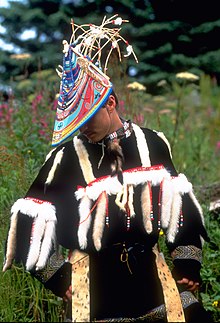Yupik peoples

Sugpiaq dancer with Agnguaq
|
|
| Total population | |
|---|---|
| 35,700 | |
| Regions with significant populations | |
|
|
34,000 |
|
|
1,700 |
| Languages | |
|
Yupik languages, English (in Alaska), Russian (in Siberia) |
|
| Religion | |
| Christianity (mostly Russian Orthodox and Moravian), Shamanism, Atheism | |
| Related ethnic groups | |
| Aleut, Inuit, Iñupiat, Sirenik | |
The Yupik are a group of indigenous or aboriginal peoples of western, southwestern, and southcentral Alaska and the Russian Far East. They are Eskimo and are related to the Inuit and Iñupiat peoples. Yupik peoples include the following:
The Central Alaskan Yupik are by far the most numerous of the various Alaska Native groups and speak the Central Alaskan Yup'ik language, a member of the Eskimo–Aleut family of languages.
As of the 2001 U.S. Census, the Yupik population in the United States numbered over 24,000, of whom over 22,000 lived in Alaska, the vast majority in the seventy or so communities in the traditional Yup'ik territory of western and southwestern Alaska. US census data for Yupik include 2,355 Sugpiaq; there are also 1,700 Yupik living in Russia.
Yup'ik (plural Yupiit) comes from the Yup'ik word yuk meaning "person" plus the post-base -pik meaning "real" or "genuine." Thus, it means literally "real people." The ethnographic literature sometimes refers to the Yup'ik people or their language as Yuk or Yuit. In the Hooper Bay-Chevak and Nunivak dialects of Yup'ik, both the language and the people are known as Cup'ik.
The use of an apostrophe in the name "Yup’ik", compared to Siberian "Yupik", exemplifies the Central Yup’ik’s orthography, where "the apostrophe represents gemination [or lengthening] of the ‘p’ sound".
The "person/people" (human being) in the Eskimo (Yupik and Inuit) languages:
The common ancestors of the Eskimo and Aleut (as well as various Paleo-Siberian groups) are believed by archaeologists to have their origin in eastern Siberia, arriving in the Bering Sea area about 10,000 years ago. Research on blood types, confirmed by later linguistic and DNA findings, suggests that the ancestors of American Indians reached North America before the ancestors of the Eskimo and Aleut. There appear to have been several waves of migration from Siberia to the Americas by way of the Bering land bridge, which became exposed between 20,000 and 8,000 years ago during periods of glaciation. By about 3,000 years ago, the progenitors of the Yupiit had settled along the coastal areas of what would become western Alaska, with migrations up the coastal rivers—notably the Yukon and Kuskokwim—around 1400 AD, eventually reaching as far upriver as Paimiut on the Yukon and Crow Village on the Kuskokwim.
...
Wikipedia
